An Adaptive Traffic-Calming Measure and Effectiveness Evaluation in a Large Urban Complex of Shanghai, China
Abstract
:1. Introduction
2. Materials and Methods
2.1. Jinding Nine-Rectangle-Grid Area Introduction
2.2. Simulation Platform
2.3. Adaptive Traffic Volume Control
3. Results
4. Conclusions
Author Contributions
Funding
Institutional Review Board Statement
Informed Consent Statement
Data Availability Statement
Conflicts of Interest
References
- Menendez, M.; Ambühl, L. Implementing Design and Operational Measures for Sustainable Mobility: Lessons from Zurich. Sustainability 2022, 14, 625. [Google Scholar] [CrossRef]
- Hang, Z.; Jun, W. Research on the Development Mode of Slow Traffic System in Cities Based on Low-Carbon Concept. J. Innov. Sustain. RISUS 2011, 2, 33–39. [Google Scholar] [CrossRef] [Green Version]
- Distefano, N.; Leonardi, S. Evaluation of the Effectiveness of Traffic Calming Measures by SPEIR Methodology: Framework and Case Studies. Sustainability 2022, 14, 7325. [Google Scholar] [CrossRef]
- Nadafianshahamabadi, R.; Tayarani, M.; Rowangould, G. A Closer Look at Urban Development under the Emergence of Autonomous Vehicles: Traffic, Land Use and Air Quality Impacts. J. Transp. Geogr. 2021, 94, 103113. [Google Scholar] [CrossRef]
- Balant, M.; Lep, M. Comprehensive Traffic Calming as a Key Element of Sustainable Urban Mobility Plans—Impacts of a Neighbourhood Redesign in Ljutomer. Sustainability 2020, 12, 8143. [Google Scholar] [CrossRef]
- Pérez-Acebo, H.; Ziolkowski, R.; Gonzalo-Orden, H. Evaluation of the Radar Speed Cameras and Panels Indicating the Vehicles’ Speed as Traffic Calming Measures (TCM) in Short Length Urban Areas Located along Rural Roads. Energies 2021, 14, 8146. [Google Scholar] [CrossRef]
- Paszkowski, J.; Herrmann, M.; Richter, M.; Szarata, A. Modelling the Effects of Traffic-Calming Introduction to Volume–Delay Functions and Traffic Assignment. Energies 2021, 14, 3726. [Google Scholar] [CrossRef]
- Yang, Y.; Zhang, X.; Zhang, J.; Shang, H. Deriving Environment-Friendly Speed Limit Scheme Using an Integrated Traffic Simulation Framework. J. Air Waste Manag. Assoc. 2021, 71, 633–649. [Google Scholar] [CrossRef]
- Xu, G. Research on Traffic Calming Measures and Its Evaluation in Urban Areas; Southeast University: Nanjing, China, 2016. [Google Scholar]
- Zhou, F. Research on Measures and Evaluation Based on Urban Traffic Tranquilization. Technol. Mark. 2017, 24, 330–331. [Google Scholar]
- Zhao, Q. Research and Practice of Quiet Design of Urban Road Traffic. Urban Road Bridges Flood Control 2016, 7, 34. [Google Scholar]
- Gaca, S.; Kiec, M.; Budzynski, M. Evaluating the Effectiveness of Non-Physical Speed Management Measures. 2017. Available online: https://mostwiedzy.pl/en/publication/evaluating-the-effectiveness-of-non-physical-speed-management-measures,140283-1 (accessed on 11 August 2022).
- Solowczuk, A. Effect of Traffic Calming in a Downtown District of Szczecin, Poland. Energies 2021, 14, 5838. [Google Scholar] [CrossRef]
- Ignaccolo, M.; Zampino, S.; Maternini, G.; Tiboni, M.; Leonardi, S.; Inturri, G.; Le Pira, M.; Cocuzza, E.; Distefano, N.; Giuffrida, N.; et al. How to Redesign Urbanized Arterial Roads? The Case of Italian Small Cities. Transp. Res. Procedia 2022, 60, 196–203. [Google Scholar] [CrossRef]
- De Borger, B.; Proost, S. Road Tolls, Diverted Traffic and Local Traffic Calming Measures: Who Should Be in Charge? Transp. Res. Part B Methodol. 2021, 147, 92–115. [Google Scholar] [CrossRef]
- Zhao, C.; Liao, F.; Li, X.; Du, Y. Macroscopic Modeling and Dynamic Control of On-Street Cruising-for-Parking of Autonomous Vehicles in a Multi-Region Urban Road Network. Transp. Res. Part C Emerg. Technol. 2021, 128, 103176. [Google Scholar] [CrossRef]
- Zhai, Z.; Yang, Y.; Shen, Y.; Ji, Y.; Du, Y. Assessing the Impacts of Autonomous Bus-on-Demand Based on Agent-Based Simulation: A Case Study of Fuyang, Zhejiang, China. J. Adv. Transp. 2020, 2020, 7981791. [Google Scholar] [CrossRef]
- Du, Y.; Qin, B.; Zhao, C.; Zhu, Y.; Cao, J.; Ji, Y. A Novel Spatio-Temporal Synchronization Method of Roadside Asynchronous MMW Radar-Camera for Sensor Fusion. IEEE Trans. Intell. Transp. Syst. 2021, 1–12. [Google Scholar] [CrossRef]
- Du, Y.; Chen, J.; Zhao, C.; Liu, C.; Liao, F.; Chan, C.-Y. Comfortable and Energy-Efficient Speed Control of Autonomous Vehicles on Rough Pavements Using Deep Reinforcement Learning. Transp. Res. Part C Emerg. Technol. 2022, 134, 103489. [Google Scholar] [CrossRef]
- Zhao, C.; Zhu, Y.; Du, Y.; Liao, F.; Chan, C.-Y. A Novel Direct Trajectory Planning Approach Based on Generative Adversarial Networks and Rapidly-Exploring Random Tree. IEEE Trans. Intell. Transp. Syst. 2022, 1–12. [Google Scholar] [CrossRef]
- Zhao, C.; Song, A.; Du, Y.; Yang, B. TrajGAT: A Map-Embedded Graph Attention Network for Real-Time Vehicle Trajectory Imputation of Roadside Perception. Transp. Res. Part C Emerg. Technol. 2022, 142, 103787. [Google Scholar] [CrossRef]
- Krajzewicz, D.; Erdmann, J.; Behrisch, M.; Bieker, L. Recent Development and Applications of SUMO-Simulation of Urban MObility. Int. J. Adv. Syst. Meas. 2012, 5, 128–138. [Google Scholar]
- Lopez, P.A.; Behrisch, M.; Bieker-Walz, L.; Erdmann, J.; Flötteröd, Y.-P.; Hilbrich, R.; Lücken, L.; Rummel, J.; Wagner, P.; Wießner, E. Microscopic Traffic Simulation Using SUMO. In Proceedings of the 21st IEEE International Conference on Intelligent Transportation Systems, Maui, HI, USA, 4–7 November 2018. [Google Scholar]
- Li, W.; Cai, Y.; Dinesha, U.; Fu, Y.; Di, X. CVLight: Deep Reinforcement Learning for Adaptive Traffic Signal Control with Connected Vehicles. arXiv 2021, arXiv:2104.10340. [Google Scholar]
- Mnih, V.; Kavukcuoglu, K.; Silver, D.; Graves, A.; Antonoglou, I.; Wierstra, D.; Riedmiller, M. Playing Atari with Deep Reinforcement Learning. arXiv 2013, arXiv:1312.5602. [Google Scholar]
- Zhang, X.; Zhao, C.; Liao, F.; Li, X.; Du, Y. Online Parking Assignment in an Environment of Partially Connected Vehicles: A Multi-Agent Deep Reinforcement Learning Approach. Transp. Res. Part C Emerg. Technol. 2022, 138, 103624. [Google Scholar] [CrossRef]
- Zhao, C.; Li, S.; Wang, W.; Li, X.; Du, Y. Advanced parking space management strategy design: An agent-based simulation opti-mization approach. Transp. Res. Rec. 2018, 2672, 901–910. [Google Scholar] [CrossRef]
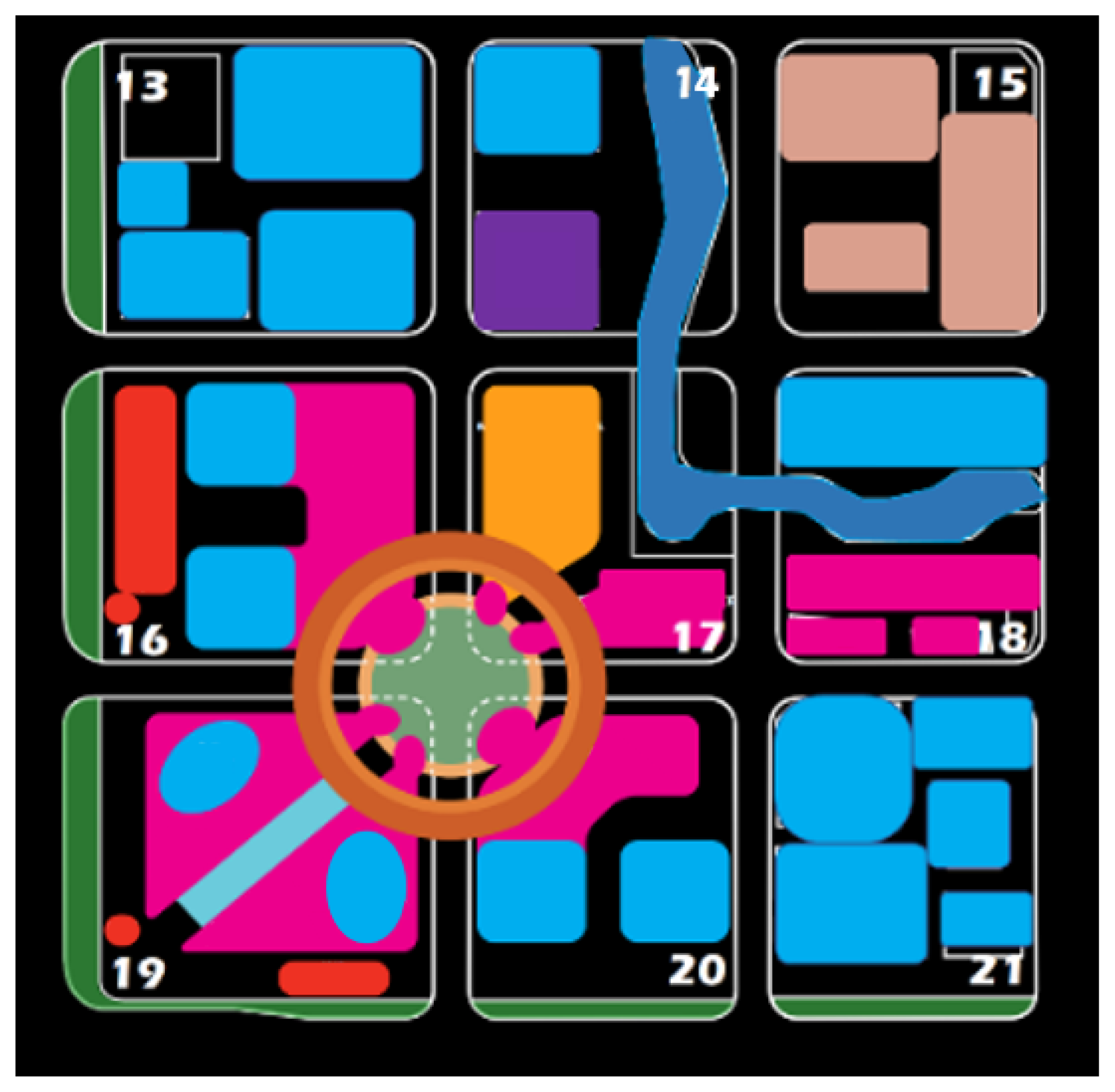
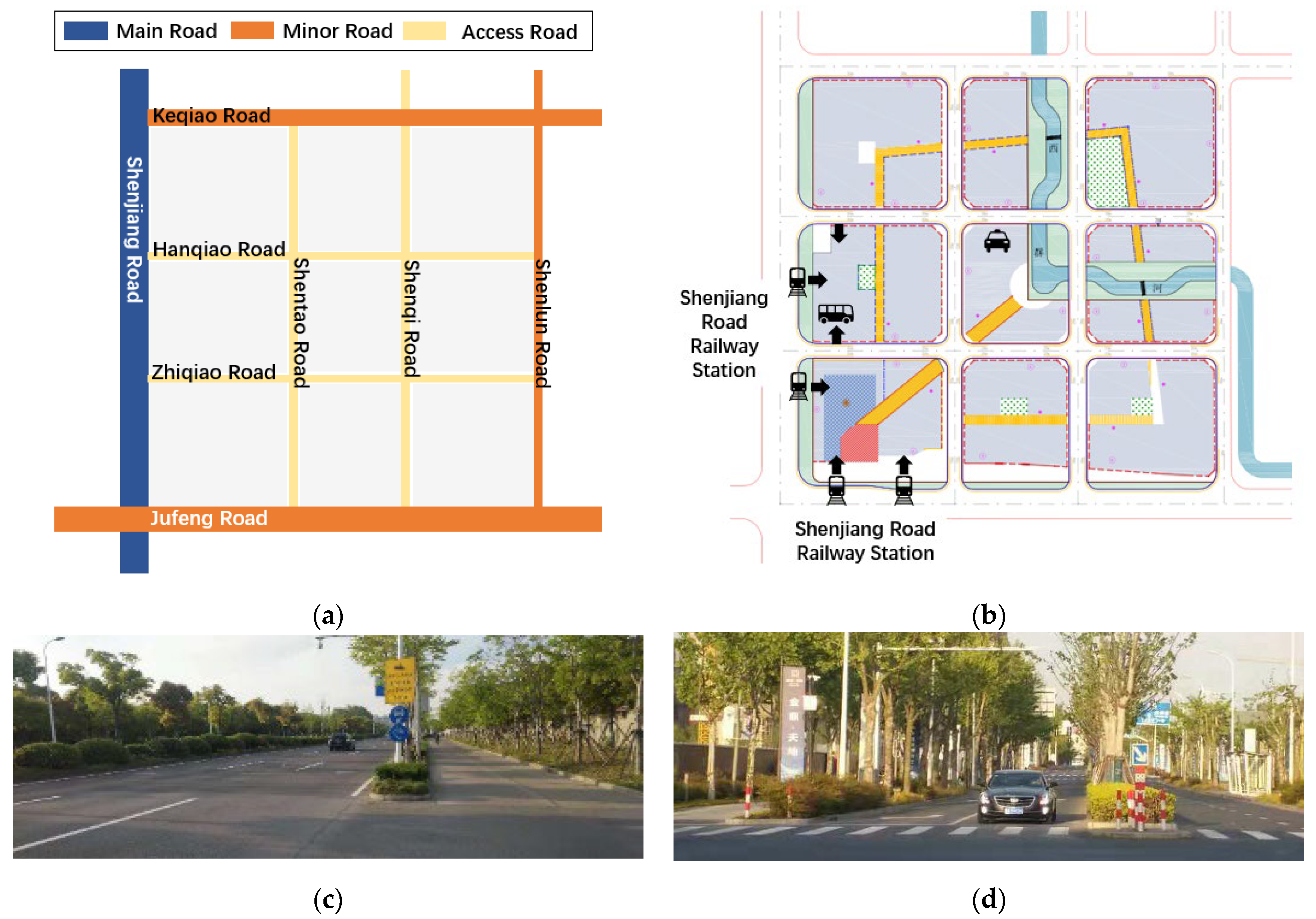
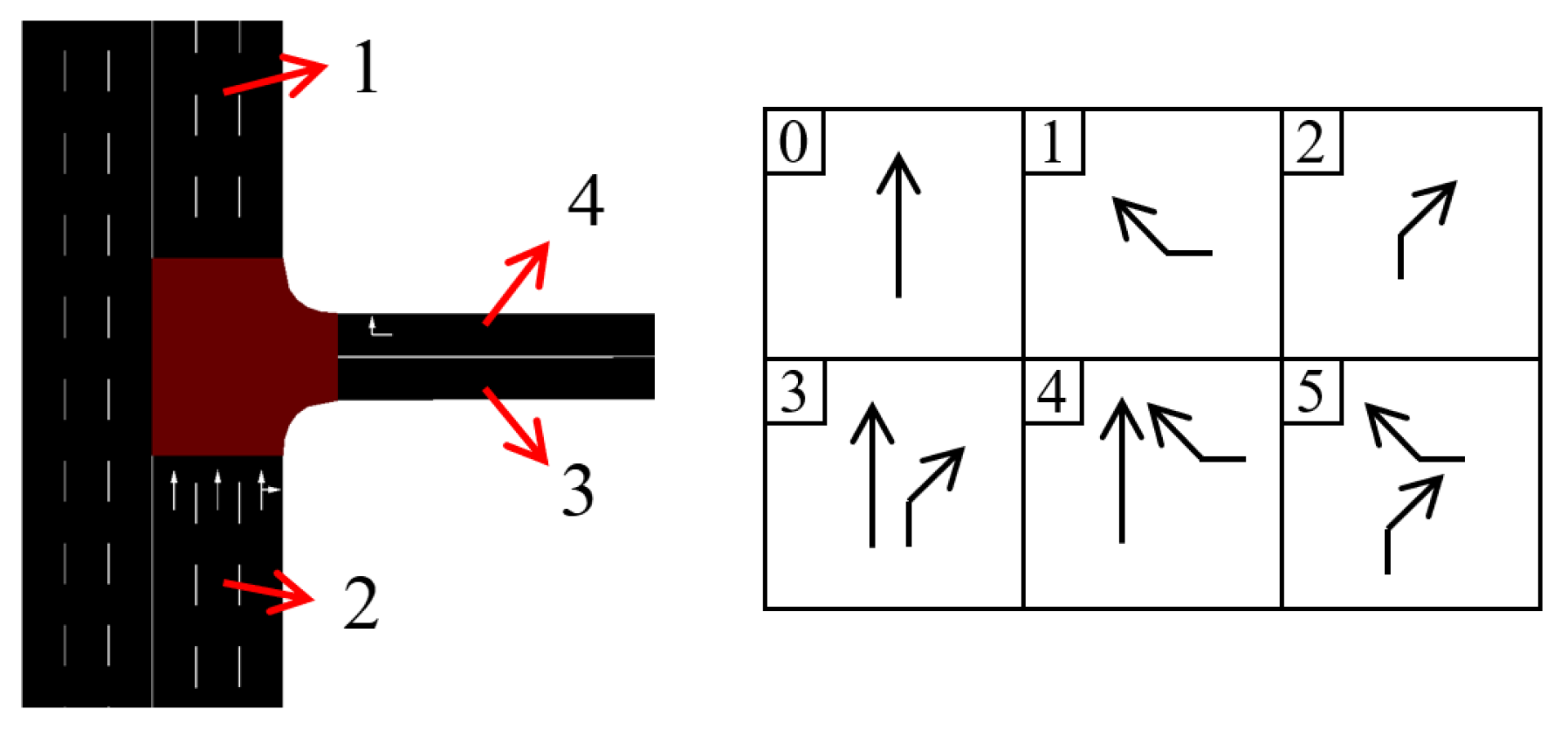
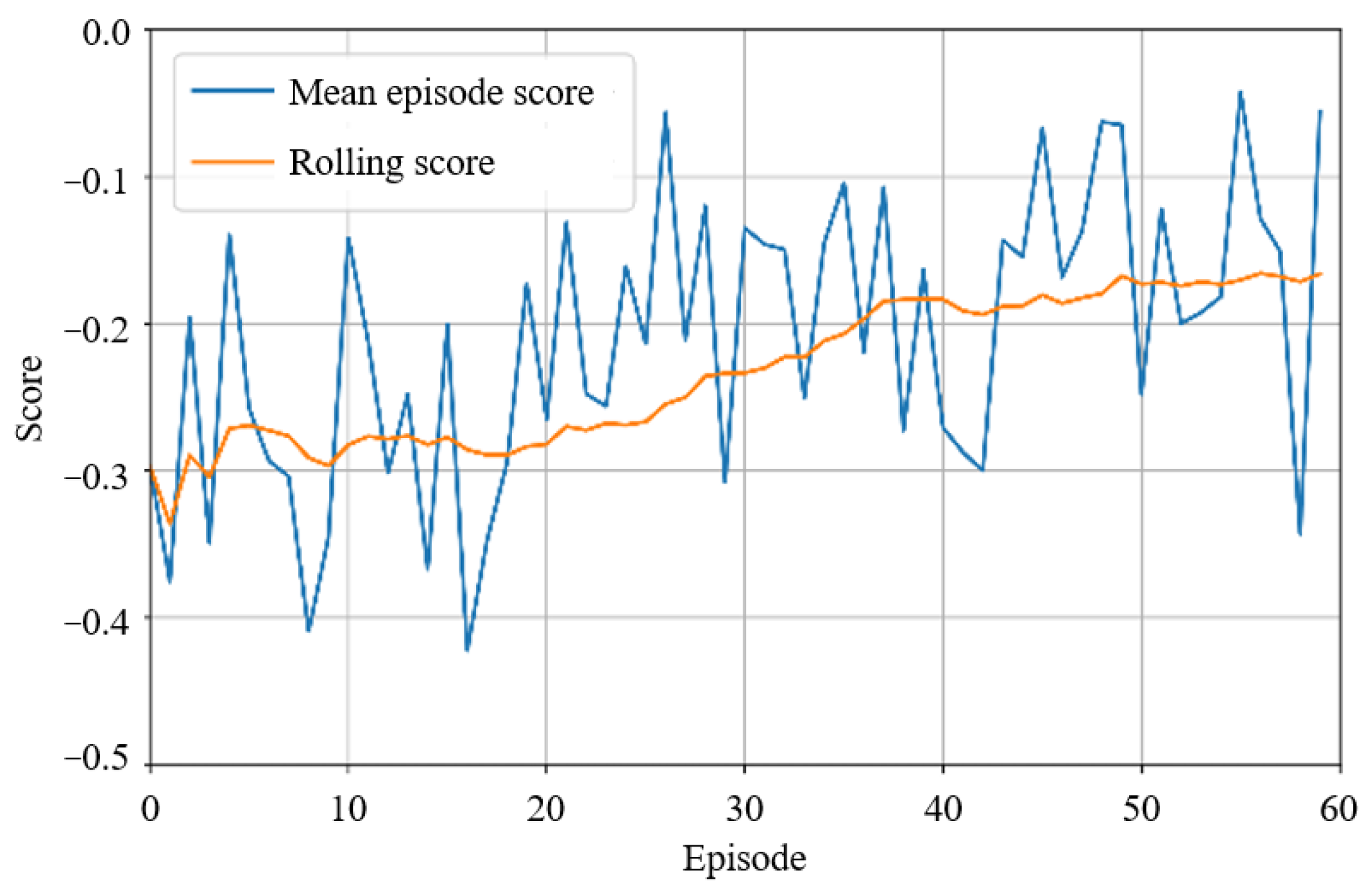


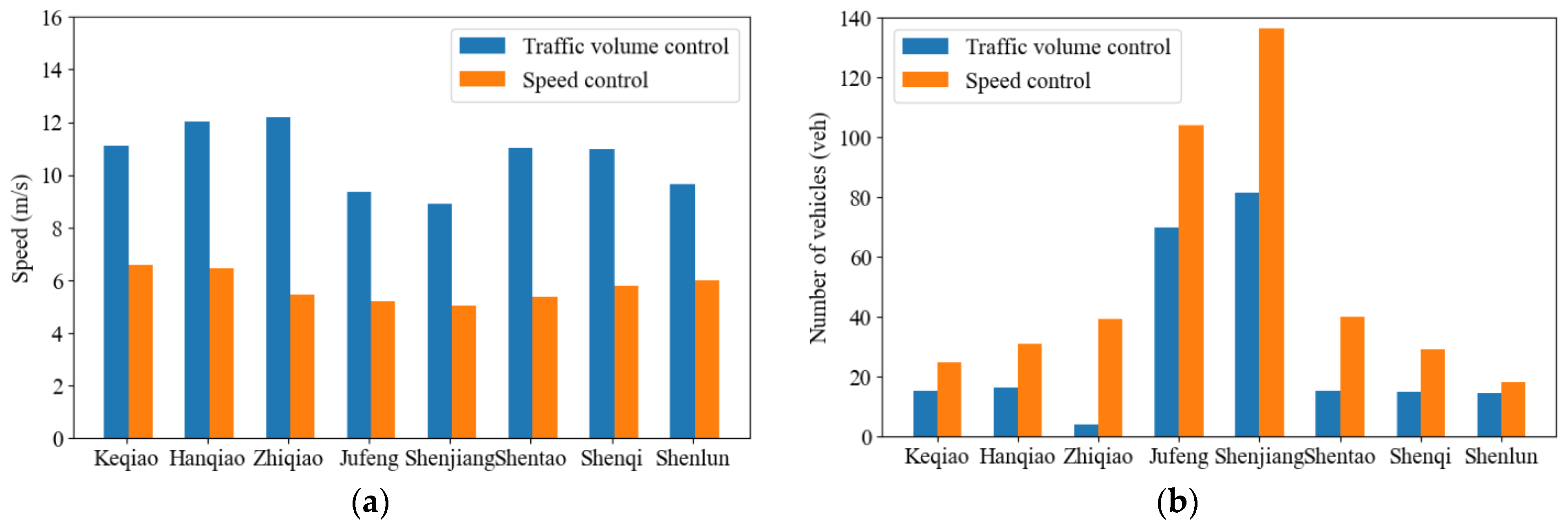
Publisher’s Note: MDPI stays neutral with regard to jurisdictional claims in published maps and institutional affiliations. |
© 2022 by the authors. Licensee MDPI, Basel, Switzerland. This article is an open access article distributed under the terms and conditions of the Creative Commons Attribution (CC BY) license (https://creativecommons.org/licenses/by/4.0/).
Share and Cite
Wang, J.; Ying, J.; Jiang, S. An Adaptive Traffic-Calming Measure and Effectiveness Evaluation in a Large Urban Complex of Shanghai, China. Sustainability 2022, 14, 13023. https://doi.org/10.3390/su142013023
Wang J, Ying J, Jiang S. An Adaptive Traffic-Calming Measure and Effectiveness Evaluation in a Large Urban Complex of Shanghai, China. Sustainability. 2022; 14(20):13023. https://doi.org/10.3390/su142013023
Chicago/Turabian StyleWang, Jindong, Jianguo Ying, and Shengchuan Jiang. 2022. "An Adaptive Traffic-Calming Measure and Effectiveness Evaluation in a Large Urban Complex of Shanghai, China" Sustainability 14, no. 20: 13023. https://doi.org/10.3390/su142013023





